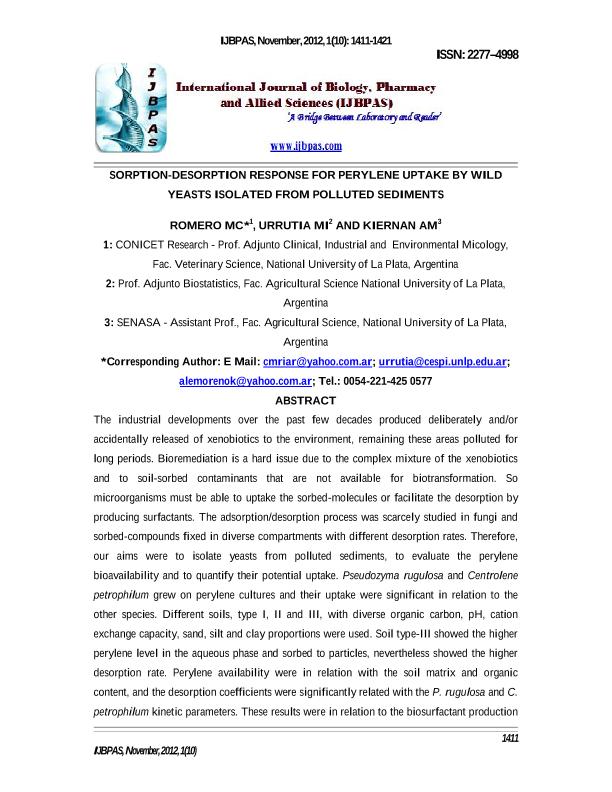Mostrar el registro sencillo del ítem
dc.contributor.author
Romero, Maria Cristina

dc.contributor.author
Urrutia, M. I.
dc.contributor.author
Moreno Kiernan, A. M.
dc.date.available
2023-05-15T11:12:53Z
dc.date.issued
2012-11
dc.identifier.citation
Romero, Maria Cristina; Urrutia, M. I.; Moreno Kiernan, A. M.; Sorption-desorption response for perylene uptake by wild yeasts isolated from polluted sediments; International Journal of Biology, Pharmacy and Allied Sciences; International Journal of Biology, Pharmacy and Allied Sciences; 1; 10; 11-2012; 1411-1421
dc.identifier.issn
2277-4998
dc.identifier.uri
http://hdl.handle.net/11336/197434
dc.description.abstract
The industrial developments over the past few decades produced deliberately and/or accidentally released of xenobiotics to the environment, remaining these areas polluted for long periods. Bioremediation is a hard issue due to the complex mixture of the xenobiotics and to soil-sorbed contaminants that are not available for biotransformation. So microorganisms must be able to uptake the sorbed-molecules or facilitate the desorption by producing surfactants. The adsorption/desorption process was scarcely studied in fungi and sorbed-compounds fixed in diverse compartments with different desorption rates. Therefore, our aims were to isolate yeasts from polluted sediments, to evaluate the perylene bioavailability and to quantify their potential uptake. Pseudozyma rugulosa and Centrolene petrophilum grew on perylene cultures and their uptake were significant in relation to the other species. Different soils, type I, II and III, with diverse organic carbon, pH, cation exchange capacity, sand, silt and clay proportions were used. Soil type-III showed the higher perylene level in the aqueous phase and sorbed to particles, nevertheless showed the higher desorption rate. Perylene availability were in relation with the soil matrix and organic content, and the desorption coefficients were significantly related with the P. rugulosa and C. petrophilum kinetic parameters. These results were in relation to the biosurfactant production by both fungal species. Desorption parameters significantly fitted perylene uptake, with R2 = 0.97 for P. rugulosa and R2 = 0.95 for C. petrophilum. Biosurfactants and extracellular enzymes production explained the perylene degradation by both yeasts, being the results confirmed by the surface tension measurements.
dc.format
application/pdf
dc.language.iso
eng
dc.publisher
International Journal of Biology, Pharmacy and Allied Sciences
dc.rights
info:eu-repo/semantics/openAccess
dc.rights.uri
https://creativecommons.org/licenses/by-nc-sa/2.5/ar/
dc.subject
BIOAVAILABILITY
dc.subject
CENTROLENE PETROPHILUM
dc.subject
PERYLENE
dc.subject
PSEUDOZYMA RUGULOSA
dc.subject
SORPTION/DESORPTION MECHANISMS
dc.subject.classification
Ciencias Medioambientales

dc.subject.classification
Ciencias de la Tierra y relacionadas con el Medio Ambiente

dc.subject.classification
CIENCIAS NATURALES Y EXACTAS

dc.title
Sorption-desorption response for perylene uptake by wild yeasts isolated from polluted sediments
dc.type
info:eu-repo/semantics/article
dc.type
info:ar-repo/semantics/artículo
dc.type
info:eu-repo/semantics/publishedVersion
dc.date.updated
2023-05-12T14:50:17Z
dc.journal.volume
1
dc.journal.number
10
dc.journal.pagination
1411-1421
dc.journal.pais
Nigeria

dc.journal.ciudad
Lagos
dc.description.fil
Fil: Romero, Maria Cristina. Universidad Nacional de La Plata. Facultad de Ciencias Veterinarias. Departamento de Microbiología; Argentina. Consejo Nacional de Investigaciones Científicas y Técnicas. Centro Científico Tecnológico Conicet - La Plata; Argentina
dc.description.fil
Fil: Urrutia, M. I.. Universidad Nacional de La Plata. Facultad de Ciencias Agrarias y Forestales; Argentina
dc.description.fil
Fil: Moreno Kiernan, A. M.. Universidad Nacional de La Plata. Facultad de Ciencias Agrarias y Forestales; Argentina
dc.journal.title
International Journal of Biology, Pharmacy and Allied Sciences
dc.relation.alternativeid
info:eu-repo/semantics/altIdentifier/url/https://ijbpas.com/archive/archive-single-pdf/168
Archivos asociados
